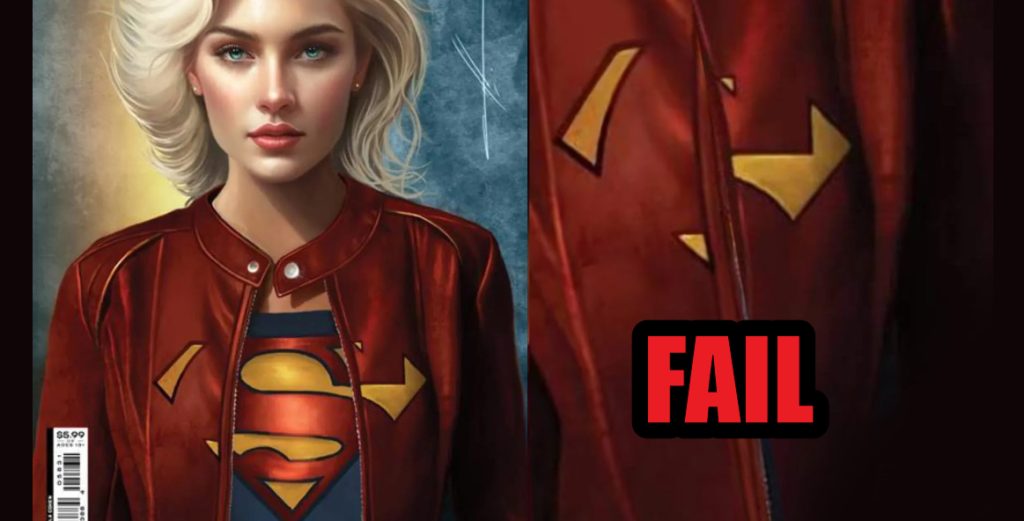
A recent DC cover by Carla Cohen is called out for a foolish misuse of Supergirl’s “shield” (or logo) which many believe to be the result of computer-generated issues at worst, editor over-sight at best. Whichever the case, it sure seems very unnatural. I did a deep dive on the artist Carla Cohen’s work to figure it out and it left me asking more questions than I started, so let’s get into it.
The cover depicts Supergirl standing in no particular pose whatsoever, exhibiting a completely blank expression, in front of a generic, abstract background. The only appeal to the intellect of the whole cover is the shield, which is pictured on the jacket incorrectly. Assuming the jacket is not invisible, the shield would look completely messed up when zipped up, making fans scratch their heads and take a second look. But wait, there’s more…

Close examination reveals the shield pattern on the jacket to be a different pattern than the one on her costume. It seems an anomaly to hand draw a different shield pattern overtop an already existing shield pattern and not catch the discrepancy between the two. Unless, of course, Carla was simply replicating the shield from reference without thinking it through.
Painters are known to lightbox, project via projector, or in layman’s terms, trace images onto canvas from photo reference. Although some do draw by hand or assist themselves by using the grid technique, the fact is that dependence on pre-existing images is strong with painters. This is traditionally taboo in for comic book art. As more painters and 3d artists are hired by major comic book publishers or commissioned by retailers, comics fans have noticed an influx of covers that feature lifeless, mistake-ridden 3d models or AI-referenced superheroes, wondering where this shift in art styles is coming from.
Diving into Carla’s Instagram, she entered the comic book industry in early 2019 and had a fast-paced career from painting work-for-hire baby pictures to full-blown DC cover artist. It appears the uphill trajectory of her career began in controversy when she was the first person to paint politician AOC on a comic cover with this variant you’ll probably recognize from Devil’s Due.
Only 3 comic book-related commissions exist on her Instagram before we see any published covers. She explains on Feb 18th, 2019 comic art is a new subject for her. Two days later, she posts about her first published cover with Archie Comics of Sabrina the Teenaged Witch for sale at ComicXposure.com. Two months later in April, her second published cover was the viral AOC cover, and then another 2 months later in June 2019, she released an exclusive Vampirella cover through Midtown comics.

The work pours in after that throughout the next couple of years. Several more Dynamite covers, Image covers, and lots of work for heavy-hitting Kickstarter indie titles including Patriotika (through Clan McDonald and others), Miss Meow (Merc Publishing), Power Hour and Hardlee Thin (Comics Elite), Notti & Nyce (Counterpoint Comics), and White Widow (Absolute Comics Group). Fast forward to Oct. 2023, her Supergirl variant cover is available in comic shops nationwide and her 14.1K Instagram followers now enjoy an array of work that they can see all day long rendered in pencils, but never actually being drawn.
Being married to one of Dynamite’s all-time top Vampirella cover artists, Lucillo Parrillo, probably helped with her career boost. Surely something steered the subject of her paintings away from chubby babies. Funny enough, it took us going back that far to get even the slightest amount of insight into her conceptual process, and still, we found very little. Every single “work in progress” video starts when her covers are already fully drawn onto paper or canvas. There’s usually a quick flash of paint blobs and then we see the already rendered piece in pencil, ready to be filled in with color. The work has already been done, like in this video:
The closest we came to finding out her layout process was in these early pictures from 2018 showing simple pencil outlines underneath the paints of baby portraits. One can likely deduce from these photos that she follows typical painting techniques and most likely uses a lightbox or projector as there are no rough, underlying sketch marks to suggest she was drawing a picture she was looking at. Instead, the lines were already clearly there for her to trace. There are also no grid lines so you can likely rule out the grid technique unless she’s looking at the grid from an app on her phone (possible) and winging it with a pencil. If you can do that though, why would you need to pencil at all when you can just wing it completely with paint, like @siobhankaufmanart does here?
This highly suggests photo references are required and this mysterious Supergirl jacket woopsie came from somewhere, in some capacity, before it made it to her canvas. Perhaps she is super skilled at 3d sculpting and simply cut out the front of a pre-shielded jacket, explaining the discrepancy. That’s a lot of effort for such an easy thing to avoid if you’re drawing from imagination, but let’s explore it.
Carla’s specific style of using shaded pencil on toned paper (one of my favorite techniques, actually), gives her pieces a very hyperrealistic aesthetic that would work very well to translate the skin tones from a 3d rendered model. Another telltale of 3d models for reference is the use of hyperrealistic celebrity faces. We did find one celebrity look-alike face on a Carla Cohen piece which at first appeared to be celebrity Rachel Weisz. However, shortly after this article was published, we were sent a tip of where this exact photo reference came from. Here it is side by side with her piece.

The practice of tracing photos is extremely controversial for comic book artists. Most notably, Marvel artist Greg Land comes to mind, who has faced heavy criticism and tracing allegations going all the way to 2008. Most recently outed was indie artist Jamie Tyndall who was caught referencing lines from a Brett Booth piece, which we broke the news on in our article: Nyobi: To Trace, or Not To Trace. Coincidentally, Tyndall is co-creator and co-owner of Merc Publishing alongside Shawn Hudachko, which publishes Miss Meow, a title Carla has done work for.
Carla’s piece is directly referenced from one of the photos inside this ArtStation reference photo pack for artists. Not only does Carla share the aptitude to frequent ArtStation like just about every 3d artist out there, but she also shares with them the complete aversion to showing her full “drawing” process on video. The work just seems to magically appear out of thin air.
One such comic book cover artist named Shikarii, a video game designer based out of India, refuses to show any video of his work in progress and also has pieces riddled with questionable mistakes and telltale signs of digital manipulation, such as this feather placement on his most recent piece (look between the legs). If you actually had your hand down there, zoomed in close, painting those feather strokes, I GUARANTEE you’d start to question what you were doing!
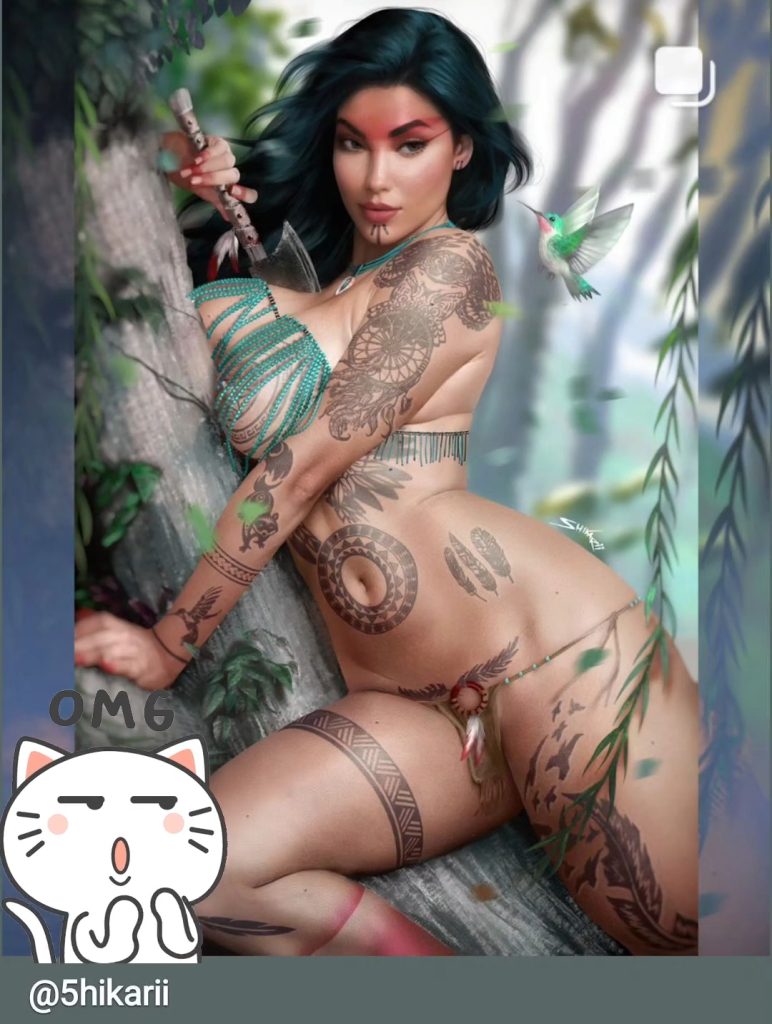
Shawn Hudachko, owner of Comics Elite (speaking on Shikarii’s behalf who claims to have social anxiety), claims these Shikarii covers are “digitally drawn” and the “faces are drawn from scratch”, then, says he never said that. Coincidentally, Shawn is one of the publishers who helped give Carla a push over the last few years of her budding career.
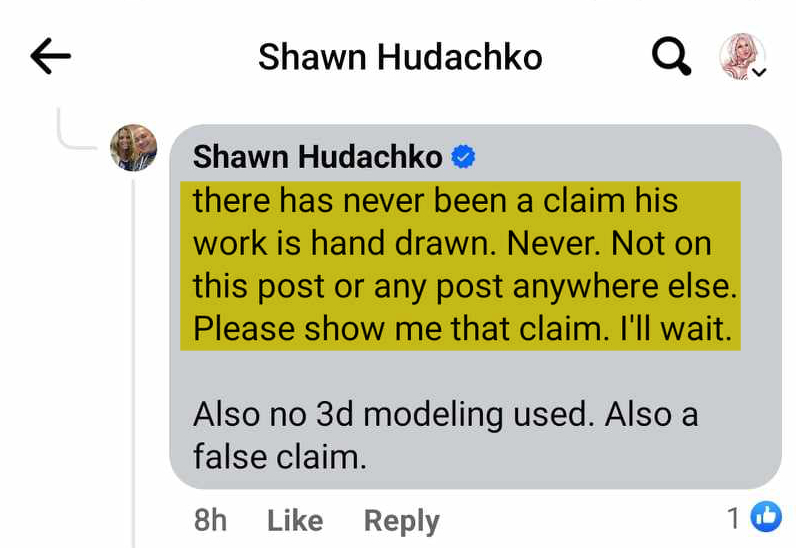
He forgets little things called “hands” do a thing we all call “drawing.”
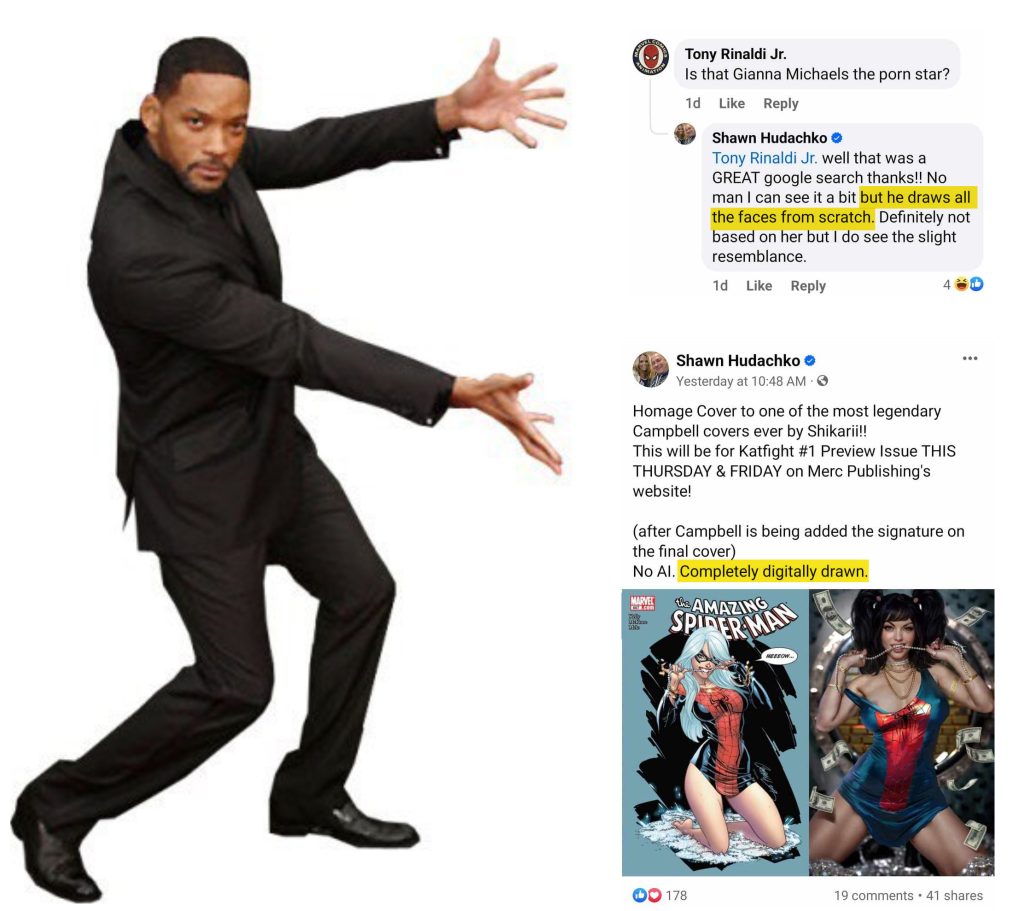
Shawn has been involved in lots of controversy himself, from recently being accused of using Chat GPT by a former employee of Merc Publishing, to critique surrounding his ethical use of celebrity likeness rights in the Shikarii covers he was commissioning, specifically one of Margot Robbie for a Miss Meow cover.
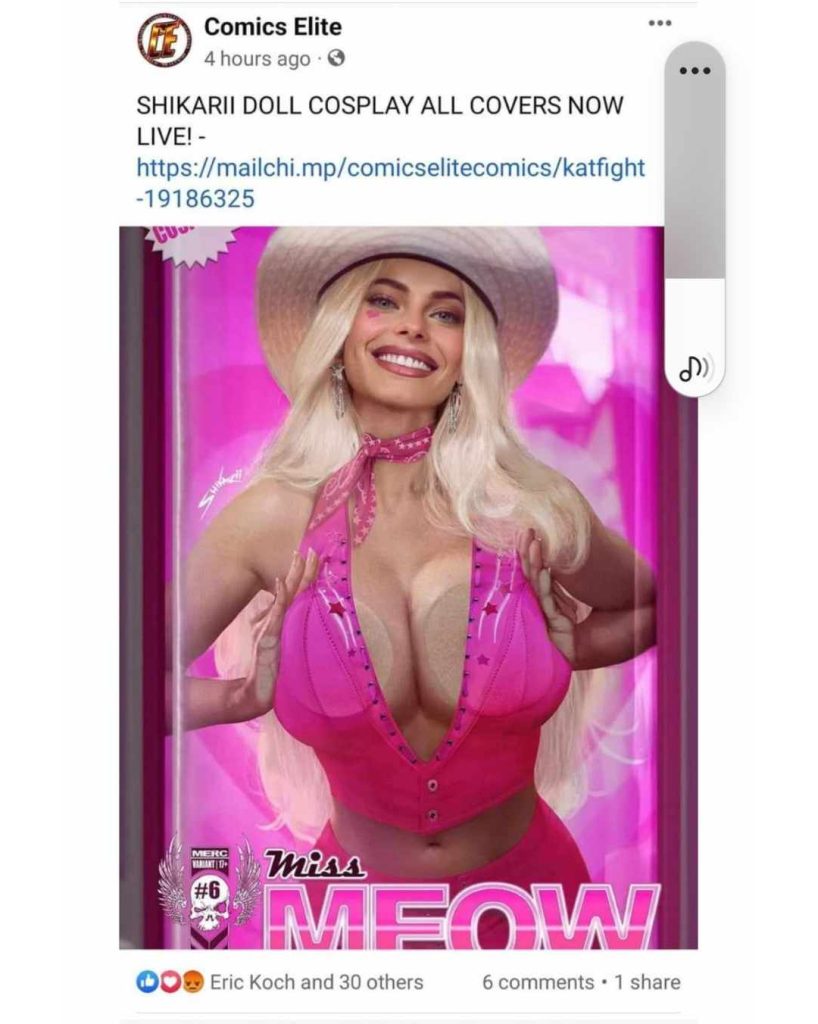
Shawn is a self-proclaimed leader in a self-proclaimed “fight against AI”, which would make a hypocrite out of him if the accusations of him using Chat GPT are true and also makes you wonder – if he’s using shortcuts, what other shortcuts are he, Shikarii, Carla, Tyndall, and others using, despite any virtue signaling to be really, really good people?
I’m still without any evidence to convince me, even in the slightest, that either Carla or Shikarii’s covers are drawn from scratch, and many other artists for that matter. I guess we should just believe everybody at face value because everyone is totally honest, right? Surely, it makes sense for a video game designer to spend hours redrawing a celebrity face that he can just download for $0-$5 and put on his 3d model, right? They put all this extra time and effort into their work because they love you, right? Not because they want your money. Maybe if Shikarii borrowed Carla’s projector, he wouldn’t have to spend 40-50 hours per cover going through such trouble. In exchange, maybe he can help pose 3d models for artists so they don’t make the mistake of cutting off jacket emblems.
The two of them should talk if they don’t already know each other since they’ve done several of the same titles from several of the same publishers. Here’s Carla pictured in front of two Comics Elite Banners covered in Shikarii’s artwork, next to one of Dynamite’s premiere cosplayers who also works with Comics Elite. Small world, right? (New York Comic Con, Oct. 2023)
This Digital Age we live in is quickly turning into the Age of Artist Accountability. The only answer for artists is to go full transparency, or else be accused for something they didn’t do, or revealed to do exactly what everyone thought they were doing. Worse yet, there is word that Instagram is mislabeling artists’ work as AI when it is not (more on that later). It’s always good to have your bases covered as an artist. Why wouldn’t you want to? I am hard but I am fair. I don’t care how people paint or make covers, I just ask for one really simple thing – honesty. Everyone seems to have a huge problem being able to stick with that.
Still, it seems that painters like Carla or 3d artists like Shikarii may be hiding their drawing process for fear of backlash from comic book fans. Money might go elsewhere if fans found out their favorite comic cover was based on a traced image or just a 3d render they thought was digitally painted. Shikarii claims social anxiety as his reason for avoiding video, but Carla certainly didn’t shy away from controversy when it came to publishing her AOC cover with Devil’s Due. Among the disapproving comments she saved and posted on her Instagram, someone mentioned boycotting the publisher while many shook their fists at her for promoting socialism, yet she circled them all with a big heart and titled it “Haters”. Pretty strong words coming from only month two of your comic book career, like you have nothing to lose.
Maybe it’s easy to sit back when the money is flowing in, leaving the responsibility of due diligence up to the unsuspecting comic book fan. What they don’t know won’t hurt them, right? Meanwhile, painters from other industries are not so shy with their process, spilling the beans on all of it.
Many flaunt the arduous process of hunting down photo references to help piece together what they have in their mind. This often includes taking carefully posed selfies, then running those through filters in Photoshop and making digital manipulations to get an exact product they want to reproduce. In the words of painter @siobhankaufmanart after she takes her own reference photos “I start photobashing the living sh*t out of the reference images”. Perhaps the mystery of the jacket shield was just a photobash mistake.
If there’s one takeaway, it’s certainly that the editors at DC are twiddling their thumbs instead of reading comics, especially in light of cover choices from last year such as Frank Miller’s Wolverine.
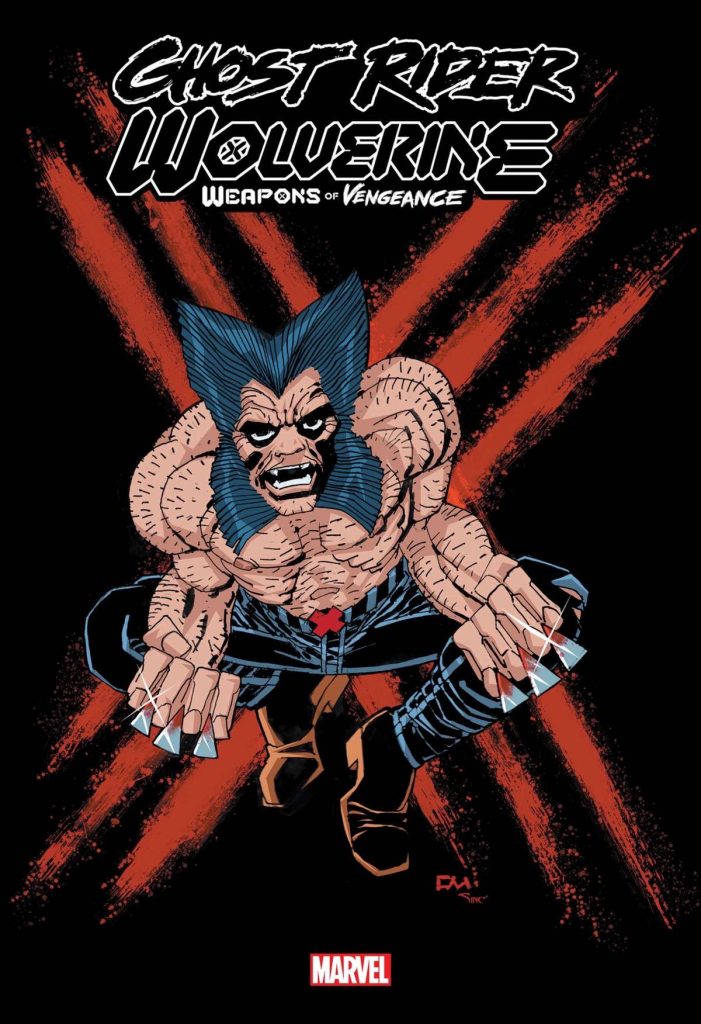
All the more reason to invest more time and energy into indie comics – it seems Diamond Distributors certainly thinks so. The other takeaway is… Don’t always depend on digital tools to do all the work for you. You might end up with unexpected results. It may even look like a Greek statue.


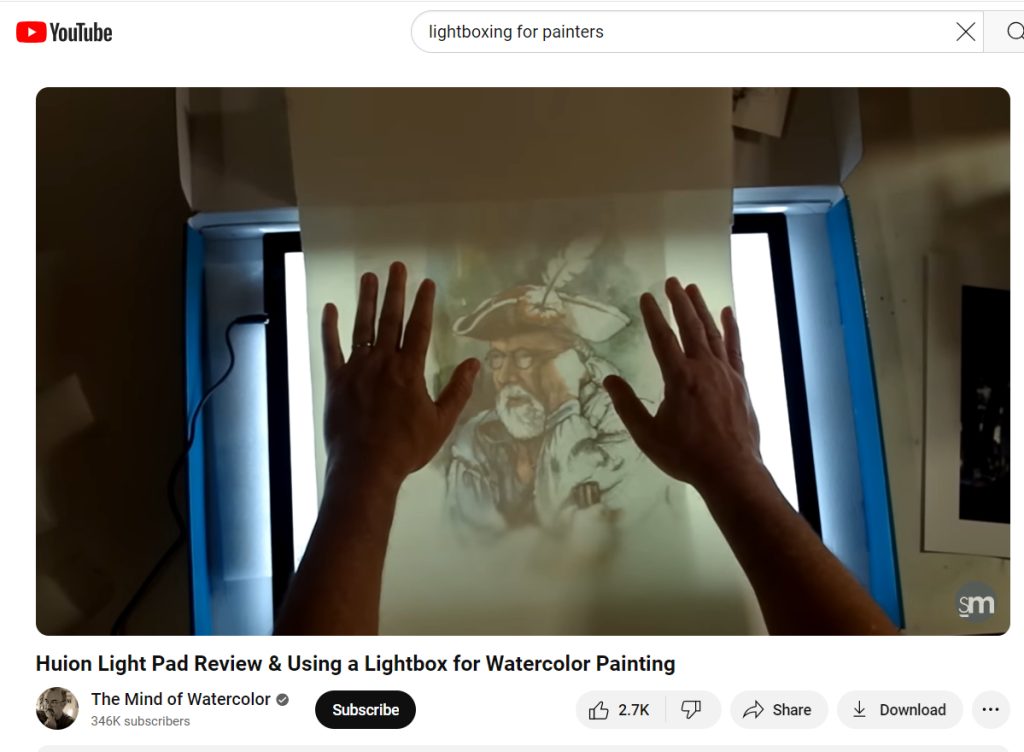
Oh, come on! The phallic symbolism of that feather sticking out from the loop holding (apologies to Matoaka) Poke-a-hooker’s chain together could be purely intentional!